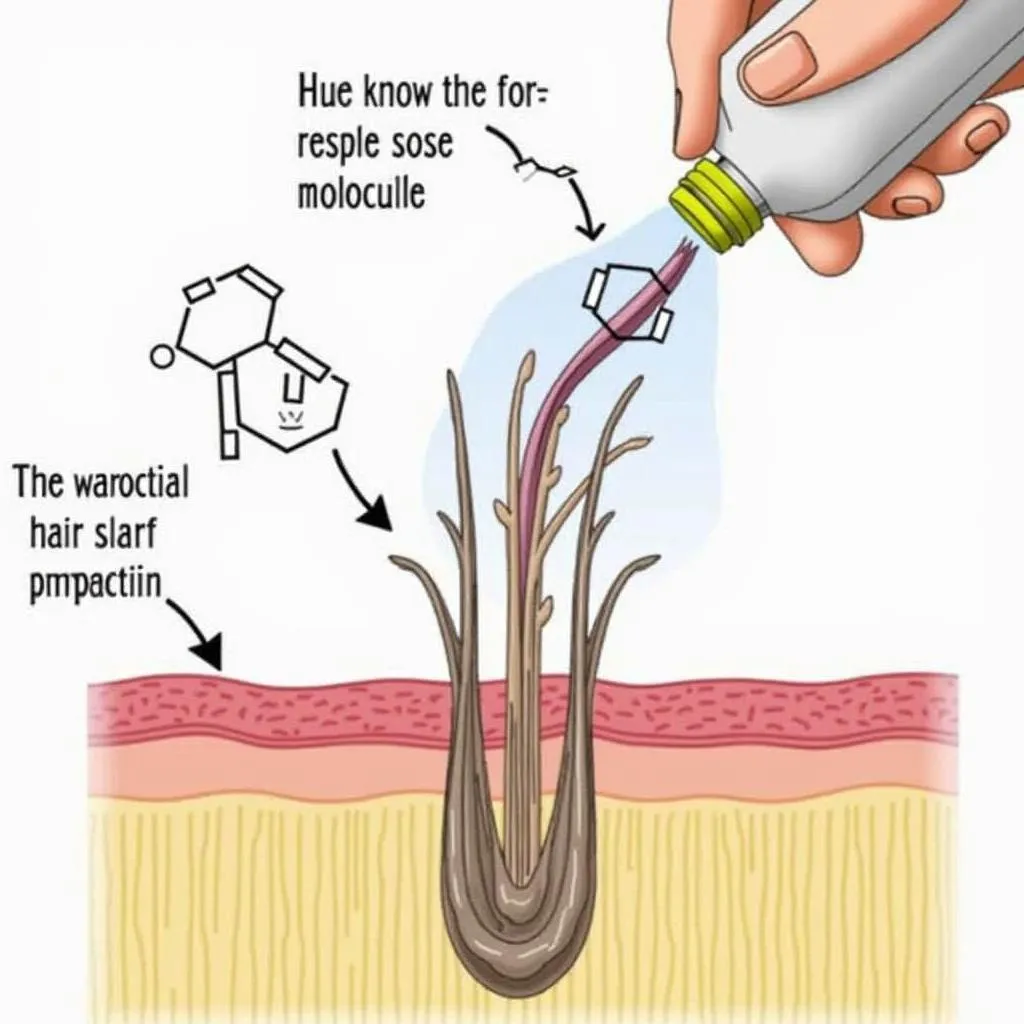Hair color remover can seem like magic in a bottle, especially when you’re facing a color disaster or simply want a fresh start. But how does this wonder product actually work? Unlike bleach, which strips away natural pigment, color remover targets only artificial color molecules. Let’s delve into the science behind this process and understand how it safely lifts unwanted dye from your hair.
Breaking Down the Chemistry: How Color Remover Tackles Dye
Hair color remover, also known as color strippers or dye removers, works by shrinking the size of color molecules that have been deposited into your hair shaft during the dyeing process. Permanent and semi-permanent hair dyes work by opening up the hair cuticle (the outermost layer) and allowing color molecules to penetrate deep inside. These molecules then expand and lock themselves within the hair’s structure, resulting in a long-lasting color change.
Color remover, however, reverses this process. It penetrates the hair shaft and breaks down the bonds that hold the large color molecules together. This shrinking process allows the color molecules to be flushed out of the hair shaft more easily, lifting the unwanted color.
 Color Remover Molecules Illustration
Color Remover Molecules Illustration
Different Types of Color Removers: From DIY to Professional Grade
There are various types of hair color removers available, ranging from DIY kits you can find at drugstores to professional-strength formulas used in salons.
- Sulfur-based removers: These are the most common type and are generally gentler on the hair. They work by breaking down the sulfur bonds in artificial color molecules.
- Bleach-free removers: As the name suggests, these formulas don’t contain bleach. They typically rely on other oxidizing agents to lift color, making them a good choice for those with sensitive scalps or damaged hair.
- Professional color correction products: Salons often use professional-grade color removers that are stronger and more effective at removing stubborn or darker shades of hair dye.
While DIY color removers can be helpful for fading or correcting minor color mishaps, it’s always advisable to consult with a professional stylist before using any strong chemical treatments on your hair, especially if you have heavily processed or damaged hair.
 Different Types of Hair Color Remover Products
Different Types of Hair Color Remover Products
Does Hair Color Remover Work on All Types of Hair Dye?
While hair color remover is effective at lifting most artificial hair colors, its effectiveness can vary depending on:
- Type of dye used: Permanent hair color is more difficult to remove than semi-permanent or demi-permanent color.
- Number of applications: If you’ve dyed your hair multiple times, especially with darker shades, it might require multiple applications of color remover to achieve the desired result.
- Hair porosity: Hair porosity refers to your hair’s ability to absorb and retain moisture. Porous hair tends to absorb more color, making it trickier to remove.
In some cases, color remover may not completely eliminate the artificial pigment but rather lighten it significantly, making it easier to achieve your desired hair color with a new dye application.
Is Hair Color Remover Damaging? Debunking the Myths
One common concern about hair color remover is its potential for damage. While it’s true that using any chemical treatment on your hair can cause some level of dryness, color remover itself is not inherently damaging when used correctly.
Remember, color remover doesn’t touch your natural hair pigment; it only targets the artificial color molecules. However, overusing color remover or not following the instructions carefully can lead to dryness and breakage. It’s crucial to follow the product instructions meticulously and consider seeking professional guidance if you’re unsure about the process.
Maintaining Your Hair Health After Using Color Remover
After using a color remover, it’s essential to pamper your hair with some extra TLC. Here are a few tips:
- Deep condition: Use a deep conditioning treatment to replenish moisture lost during the color removal process.
- Avoid heat styling: Give your hair a break from heat styling tools like straighteners and curling irons, as these can further dry out your strands.
- Use color-safe products: Switch to shampoos and conditioners specifically formulated for color-treated hair to prevent premature fading.
By incorporating these tips into your hair care routine, you can help restore your hair’s health and maintain its vibrancy.
Conclusion: Embracing the Power of Color Remover
Hair color remover is a valuable tool for those looking to correct color mishaps or simply switch up their hair color. Understanding how it works can empower you to make informed decisions about your hair and achieve the desired results safely and effectively. If you’re ever unsure about using color remover, don’t hesitate to seek advice from a professional hairstylist who can assess your hair type and guide you towards the best course of action.
FAQs
1. Can I dye my hair immediately after using color remover?
It’s generally recommended to wait at least 24-48 hours after using color remover before applying new dye. This allows your hair cuticles to close and prevents the new color from being absorbed unevenly.
2. Will color remover remove henna or other natural dyes?
Color remover is not effective at removing henna or other natural dyes, as these work differently than artificial hair dyes.
3. Can I use color remover on bleached hair?
Using color remover on bleached hair is not recommended as it can further damage your hair. It’s best to consult with a professional stylist in this case.
4. How many times can I use color remover on my hair?
It’s advisable to avoid using color remover multiple times in a row as it can dry out your hair. If you need to remove more color, wait a few days between applications and deep condition your hair thoroughly.
5. Can I use color remover if I have a sensitive scalp?
If you have a sensitive scalp, it’s best to do a patch test before applying color remover to your entire head. Apply a small amount to an inconspicuous area and wait 24 hours to check for any irritation.
Need expert advice on color correction or hair care? Don’t hesitate to contact us.
Call: 0373298888
Email: [email protected]
Visit: 86 Cầu Giấy, Hà Nội
Our team is available 24/7 to answer your questions and schedule consultations.

